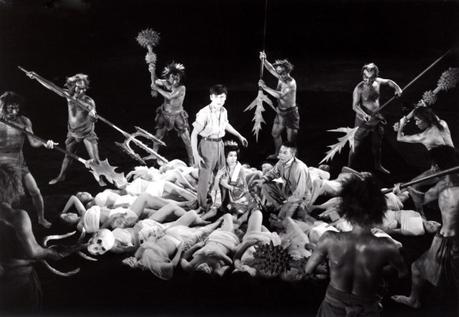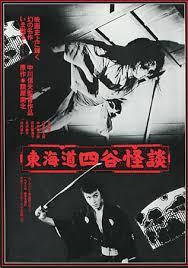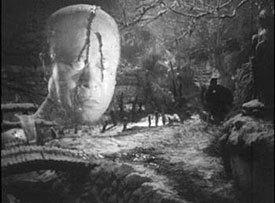Horror fans know Japan is home to some of the strangest and most unique films of the horror genre. As these movies began to grow an international fanbase and directors like Takashi Miike, Hideo Nakata, and Norio Tsuruta began to find a more global audience, it was shocking to learn that man who blazed this trail for them was someone largely unknown to moviegoers outside of Japan. That man was Nobou Nakagawa, a contemporary of legends like Akira Kurosawa and Yasujiro Ozu, but unlike those men he never found an international audience. This was largely due to the fact he worked in the horror genre, a style he originally had no interest in until he realized he was good at it. The scary flicks he made were unlike any other at the time; they were more violent, more disturbing, often had a social message, and had a kabuki-esque theatrical flair to them. In 2006, Criterion began to release his greatest movies on DVD for a brand new Western audience so cinephiles in the rest of the world could see the work of Nobou Nakagawa. In honor of the acclaimed director here are a few of his greatest works.

Jigoku (Sinners of Hell): Shiro is a bright student who seems to have is life in order. He is making good grades, he is well liked by his peers and is engaged to the lovely daughter of his professor. Unfortunately one night sends his life into a downward spiral. With his sociopathic friend Tamura behind the wheel, Shiro is party to a hit and run which leaves a Yakuza member dead. This horrible crime haunts him and leads to his fiancé's death as well as drawing the ire of the victim's family who wants vengeance. Shiro tries to escape to his hometown to comfort his dying mother where we are introduced to a host of strange unlikable characters in the village. Chief among them his philandering father who runs a shady second rate retirement home. By the middle of the movie, Shiro and everyone he has encountered die in a variety of violent ways and all end up in hell. As he ventures among the afterlife witnessing all manner of horrors, he learns his fiancé was pregnant when she died and his daughter is lost in the underworld, forcing him to find her. Audiences were shocked by Jigoku's depiction of the torments in hell as they saw people; flayed, dismembered, boiled in their own bodily fluids, ripped apart by demons, or simply forced to endlessly walk in shame.

Tokaido Yotsuya kaidan (the Ghost Story of Yotsuya in Tokaido): In 1959, Nakagawa brought moviegoers his own take on a classic kabuki ghost story, the Yotsuya Ghost Legend. The story has been adapted countless times in a variety of mediums, but many consider this film to be the finest version of the story. While trying to gain permission to marry the fragile Oiwa, dishonorable ronin Iemon, kills Oiwa's father in a fit of rage when he is denied. His crime is witnessed by the conniving Naosuke, a servant who plans to use Iemon for his own gain and becomes his ally. The ronin does eventually marry Oiwa and has a child with her but predictably he is a neglectful and worthless husband and father. As his wife suffers and cares for their child, Iemon and Naosuke plot even further evils to gain what they want. In an attempt to end his now loveless marriage, he employs the village doctor to begin to poison his wife which causes her face to become deformed. When the treachery is discovered, Iemon is forced to murder his wife. He attempts to move on and court a young heiress, but the ghost of his wife haunts him. As Oiwa's spirit continues to haunt him, more and more people learn of his wicked ways and set out to have their vengeance on him.

Kaidan Kasane-ga-fuchi (Ghost Story of Kasane Swamp/the Depths): A blind man ventures into Kasane Swamp to collect a debt he is owed by a samurai. Rather than pay the samurai decides to instead kill the blind man. His spirit craves vengeance and haunts the murderous samurai and tricks him into murdering his wife and drowning himself beneath the waters of the swamp. This leaves his son, Shinkichi, an orphan to be raised as a servant for a wealthy family in town. As he grows into a young man, Shinkichi finds himself in a love triangle between, Hisa, the daughter of the family who raised him and Rui, the daughter of the man his father killed many years before. The conflict between Hisa and Rui draws in an unscrupulous samurai who causes things to become violent after Rui becomes disfigured. The climax of the film returns the characters to Kasane Swamp where the marshes are still looking to bring in more spirits.

Kaidan Hebi-Ona (Snake Woman's Curse): Taking place in a remote village, the ruthless Onuma family hold ownership of all the land and force the citizens to live a feudal life. When the patriarch of one of the family's is killed his kindhearted wife and daughter are brought in to work for the Onuma family directly and suffer their evil firsthand. When the woman tries to save a snake discovered in the household from brutality she is killed by the Onuma. As with many of Nakagawa's films this is the catalyst for supernatural vengeance. The spirit of the mother convinces her daughter to commit suicide following a great deal of suffering. The family who derived sick pleasure from torturing their hopeless servants become tormented by the ghosts of this family. While not overtly hostile, the ghosts have an ominous presence due to the way they Nakagawa films them. It is a film where the ghosts are not the scariest element or the film but rather the way the poor are treated by the powerful.

